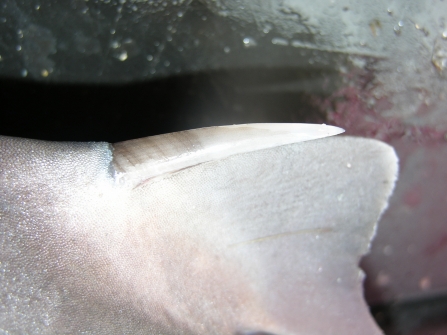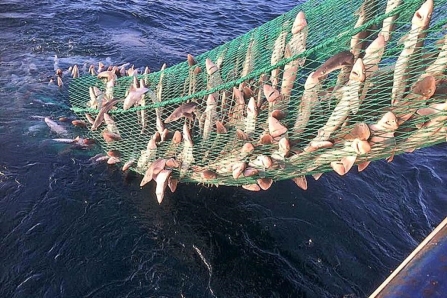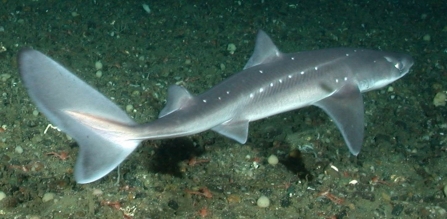Spurdog, also known as the spiny dogfish, are the cutest shark found along our shoreline. It is a slender shark species, usually grey, with occasional white spots dotted along its body with a pale underbelly. It’s most distinctive feature is the large, round eyes on the side of its head giving them a wide field of vision. Spurdog get its name from the spur (spine) at the front of its dorsal fin. The spur is defensive and secretes venom, causing swelling and pain in humans if injected – cute!
Endangered Species Exposé - Spurdog
(c) Peter Verhoog

(c) Angling Ireland
It is found in temperate waters worldwide, with populations in both the north-east Atlantic and the Irish Sea. Water temperatures in Northern Ireland are between 7 and 15 degrees Celcius, so Spurdog are present throughout most of the year, most commonly sighted around Ballycastle and Red Bay. Pregnant females have also been seen along the Antrim coast between November and January, suggesting it is pupping in this area. Pupping grounds are critical habitats for sharks meaning that it is an area important for one of its most vulnerable life-stages. Protecting these areas from overfishing and pollution would provide a haven for juvenile sharks to forage until they are adults.

(c) Fishing News
Overfishing is a major threat to Spurdog as it takes decades for a population to recover. Females reach maturity at 15 years old, considering the intense fishing pressures, this is a long time to survive before it can reproduce, usually having a small litter of 2-3 pups. Exacerbating this is the fact that Spurdog has one of the longest gestation periods of all vertebrates, lasting up to 22 months! And they will take 'resting years' in which they do not have any pups. Fishing in pupping grounds can cause stress for pregnant females, and allow juvenile Spurdog to be removed from the population before they have had time to reach maturity and reproduce. Most pupping grounds are inshore but these are some of the busiest areas due to fishing, and construction for coastal developments. These areas are the most likely to be affected by pollution from land run-off making survival for pups difficult from the beginning.
Spurdog meat and fins are in high demand throughout Europe. Livers of Spurdog are used for fish oil and the fins are often exported to Asia to be used in cheap versions of shark fin soup making this species desirable for commercial fisheries. However, at the current rate of fishing, this species is much more likely to be caught before ever reproducing. This has led to the IUCN Red List of Threatened Species to label Spurdog as endangered in Ireland and critically endangered throughout the northeast Atlantic Ocean.

(c)NOAA
You may have unknowingly eaten this lil guy. Spurdog is commonly caught and sold to takeaways under ambiguous names that have no reference to shark such as ‘rock salmon,’ ‘flake’ or ‘rock eel’ to hide the fact that an endangered shark species is being sold. Thankfully there are no longer any fisheries that target Spurdog but many are still taken as by-catch or caught in vessels outside UK and Irish waters where it is not protected. Choose sustainable seafood, check the Cornwall Good Seafood Guide for more information www.cornwallgoodseafoodguide.org.uk and ask your local fish and chippy what they’re selling!

